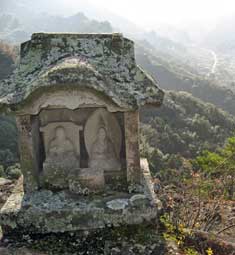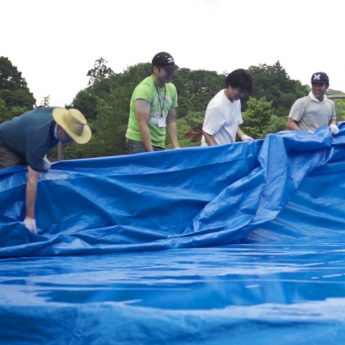Adventure firms run by Britons take visitors off the beaten path
• Alternative to urban tourism
• Nakasendo Way is oldest trekking tour
• Yakushima visitors may double by 2015
The majority of foreign tourists who come to Japan are attracted by the bright lights and ultra-modern skyscrapers of Tokyo or Osaka, the shopping opportunities, the cuisine or the well-worn tourist routes of Kyoto, Nara or Kamakura. But a growing number of visitors want to take the road less travelled.
“Prior to Walk Japan, no one really marketed the country as an outdoors destination”, said Paul Christie, the head of domestic operations for the firm.
“Even now, by far the bulk of tours available to Japan are of the tour-bus type: being driven around from one sightseeing spot to the next and, generally, staying in large hotels or resort complexes”, Christie said, shaking his head in horror at the thought.
Walk Japan was set up in 1992 as a remedy to that form of mass tourism.
In 2008, the firm showcased the very best of off-the-beaten-track Japan to just 380 people; this year, 1,200 clients will get to experience that other side of the nation.
The firm’s guided hikes include the 10-day Kunisaki Trek, which starts in Fukuoka and wends its way to Yufuin. Walkers follow in the steps of Buddhist monks along forest trails and stay in traditional ryokan (Japanese inns).
The Snow Country Trek is a more physically demanding, seven-day expedition that starts in Tokyo and finishes in Nagano. Hikers are occasionally required to wear snowshoes to explore hidden gems such as little-known farming villages in deep valleys with plenty of powder snow.
“The Nakasendo Way tour is our oldest, at 22 years, and our most successful”, said Christie, who is originally from Whitstable in Kent, but first came to Japan in 1987.
“It is popular because it allows us not only to experience some beautiful areas of Japan, but also to explore Japan’s history, society, politics, education and much else about the country that is often little understood”, he said.
“These elements are common to a greater or lesser extent in our other 16 scheduled tours”.
The entire Nakasendo walk is 534km in length, with Walk Japan taking on a stretch of about 120km through the best sections in Gifu and Nagano prefectures over 11 days. The journey starts in Kyoto and ends at Nihonbashi in Tokyo.
The firm aims to provide tours that cater to all levels of experience and ability, and word-of-mouth recommendations have been vital in building its reputation, according to Christie.
“There are a number of other recently established companies providing walking tours”, he said. “The numbers and their scale of business are significantly smaller. We welcome the competition as it helps us to broaden the market we all work in and keeps us at Walk Japan on our toes”.
The difference in the Walk Japan product lies with the guides’ broad and deep knowledge of Japan, based on the firm’s three core principles of interest or learning, entertainment and efficiency. This means clients can make the most of both their money and time.
“Our tours do provide clients with a deeper understanding of and greater affinity with Japan and its people through a pleasurable experience”, said Christie.

Helen McNamara and Steve Bell, the founders of YES, believe Yakushima is a must-see destination for any visitor to Japan.
Just say YES
A more recent addition to the outdoor tourism sector is Yakushima English Services (YES), which was set up in late 2012 and focuses on one of the most breathtaking parts of the country.
The firm was founded by Helen McNamara, originally from Yorkshire, who first arrived in Japan in 1996, and Northumberland-born Steve Bell.
YES was set up to assist foreign tourists with problems they typically face when they arrive on Yakushima island.
“Difficulties were mainly due to the lack of information available in English about the island”, said Bell, who has lived in Japan since 1999.
“It was also very apparent how ill prepared the majority of local businesses were in dealing with international visitors”, he said. “We felt we were in a unique position to use our skills to bridge this communication gap and provide a service that would benefit both international tourists and the local people.
“We also knew that Yakushima was a must-see destination for any visitor to Japan, and if we could make it an easier place to visit then we could, as a business, turn it into a successful venture”.
An estimated 10,000 foreigners visited Yakushima in 2012, and the Kagoshima prefectural government believes that figure could hit 20,000 a year by 2015, thanks to Tokyo’s winning bid for the 2020 Olympics.
If nearby Amami Oshima is granted UNESCO World Heritage status, there will be even more reasons for the region to become part of the “essential Japan” tour, Bell added.
YES provides a free booking service for accommodation, car and bike rental, English-speaking hiking guides, island tours and outdoor activities ranging from kayaking to canyoning and scuba diving.
“We offer a very personal service, answering questions, offering advice and information about anything related to either Yakushima or Japan”, he said.
“Since the service began in May, there has been a terrific response from foreign visitors”, he said, with the website recording nearly 1mn hits since it went live.
“There has also been an enthusiastic response from local businesses and the Yakushima Tourist Board, which can now clearly see the benefits of having this kind of English booking service on the island.
“Where there once was confusion, misunderstanding and a lot of stress, there is now a smooth process that both foreign tourists and locals can rely upon”.
YES’s second objective is providing English training and education to local businesspeople and residents of the island.
“Top of the list for things to do is to get on the hiking boots—and quite often the raincoat—and head off into the forests and mountains”, he said.
“One word of caution: aside from the major routes, please don’t treat the trails on Yakushima as though they are a walk in the park. And if you do decide to get off the beaten track then contact YES for a local English-speaking guide.
“The mountain climbs range from achievable for a beginner, with a few challenges along the way, to downright challenging!” he said.
“Within a few kilometres, the island goes from sea level to just under 2,000 meters and so these climbs are intensive.
“All the scary stuff aside, the forests are simply stunning and being in the mountain range feels as though you are in the presence of the gods”.
Asked why Japan is such a great place for enjoying the outdoors, Walk Japan’s Christie ticks off a list of reasons—that begins with the Japanese people themselves.
“They are a joy to be with and for our clients to experience”, Christie said. “Otherwise, Japan has a great history and culture with which to ‘colour’ our tours, great cuisine and a genuinely different but pleasurable lifestyle.
“The country is also very underdeveloped when it comes to tourism, allowing us plenty of future opportunity to develop Walk Japan and provide unique experiences to our clients”, he said.



